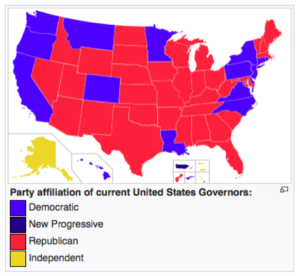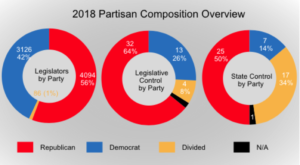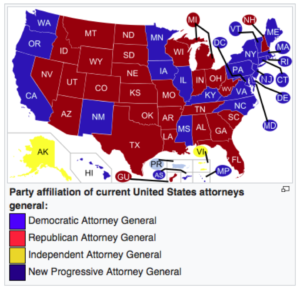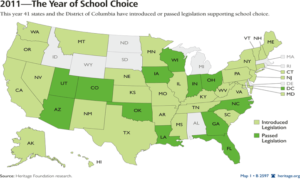
In this first of a two-part series, we highlight the current state of GOP-held majorities at the national and state level, and some of the legislative achievements made possible by those strongholds. In part two, we’ll offer some ideas on what to expect if electoral sentiment shifts to Democrats in November. Summary:
Over the last seven years, Republicans have made huge electoral gains across the country. As a result, many Republican-led policies became law. In 2018, there will be significant discussion about the possibility that Republicans will lose seats across the country. If those predictions come to fruition, we may see new Democratic-led policies.
GOP Majorities Overview
Republicans hold 33 governors’ offices, have majorities in 32 legislatures and control both the governor’s office and legislature in 25 states — their highest since 1952. Democrats control both the governor’s office and legislature in only about a half-dozen states; the rest have politically divided governments (Ballotpedia).
Summary of GOP Majorities
Trifecta (Ballotpedia)
In 26 states, Republicans now hold the governorship and both houses of the state legislature — a state-level trifecta similar to the current national trifecta, where Republicans hold the White House and have a majority in both the House and the Senate.
Governors (National Governors Association)
State Governors: 33 Republicans (66%), 16 Democrats, 1 Independent. Republican control of governorships has been on the rise since just prior to 2010. The only other periods in modern political U.S. history that saw similar levels of Republican control were the late 1990s and 1970.
State Legislatures (NCSL State Partisan Composition)
As of 2018, Republicans have legislative control of 32 states. This has been on the rise since 2010 when Republicans controlled only 14 state legislatures. It is the highest point in the NCSL data that goes back to 1997.
State Attorneys General (National Association of Attorneys General)
The current party composition of the state attorneys general are: 27 Republicans, 22 Democrats, 1 Independent. The composition for the District of Columbia and territories are: 3 Democrats, 1 Republican, 1 New Progressive, 1 Independent.
Policies Passed Under These Majorities
Included in the policies is President Trump’s Tax Reform Plan (Tax Cuts and Jobs Act), which happened in 2017.
Right to Work Laws and Bills
States with right-to-work laws enacted from 2011 to present: Indiana (2012), Kentucky (2017), Michigan (2012), Missouri (adopted 2017, postponed to 2018 for citizen voting), West Virginia (2016), and Wisconsin (2015).
School Choice
In 2011, 41 states and D.C. introduced or passed legislation supporting school choice. (Heritage Foundation)
In 2015, seven states created new voucher programs and nine states expanded current voucher programs. (New Vouchers, Expanded Vouchers) As of 2016, 30 states have some sort of school choice program. (States with School Choice)
Concealed Carry on Campuses (Guns on Campus: Overview)
Over the last five years, campus safety legislation has been a hot issue across the country. In 2013, at least 19 states introduced legislation to allow concealed carry on campus in some regard and in the 2014 legislative session, at least 14 states introduced similar legislation. Tennessee passed a bill in 2016, which permits higher education faculty to carry handguns after notifying local law enforcement.
In 2015, Texas became the eighth state to allow concealed carry weapons on college campuses. In December 2016, Governor Kasich of Ohio signed into law SB 199, which lifts the ban on firearms on college campuses and leaves the decision to individual institutions.
Abortion Restrictions (Policy Trends in the States)
States continued to enact laws regarding abortion in 2017, with 19 states adopting 63 new restrictions on abortion rights and access. That is the largest number of abortion restrictions enacted in a year since 2013. Including those adopted in 2017, states have enacted 401 abortion restrictions since January 2011. The last seven years account for 34% of the 1,193 abortion restrictions enacted by states since the 1973 U.S. Supreme Court decision legalizing abortion in Roe v. Wade.
In Part 2 of this series, we’ll discuss Democratic policy priorities that may emerge if state or federal legislatures flip blue in this year’s mid-term elections.










